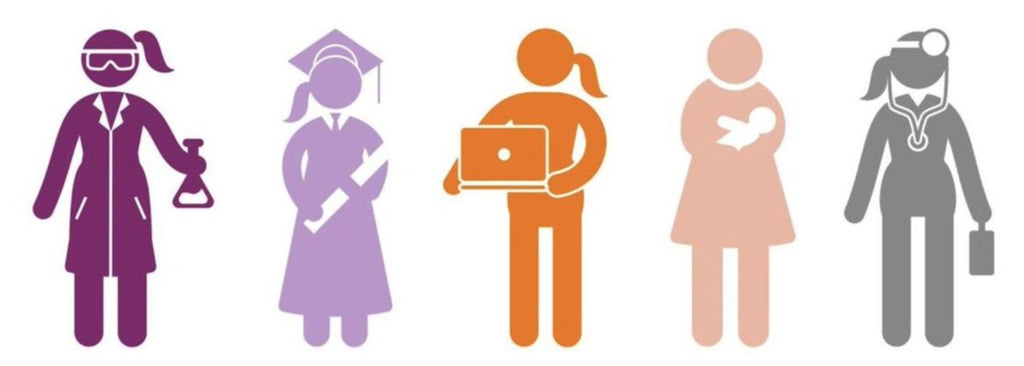In the early 20th century, most women did not work outside the home, and those who did were primarily young and unmarried. In that era, just 20 percent of all women were “gainful workers,” and only 5 percent of those married. Of course, these statistics somewhat understate the contributions of married women to the economy beyond housekeeping and childrearing, since women’s work in the home often included work in family businesses and the home production of goods, such as agricultural products, for sale.
Between the 1930s and mid-1970s, women’s participation in the economy continued to rise, with the gains primarily owing to an increase in work among married women. By 1970, 50 percent of single women and 40 percent of married women were in the workplace. Several factors contributed to this rise. First, due to mass high school education, graduation rates rose. At the same time, new technologies contributed to an increased demand for clerical workers, and these jobs were increasingly taken on by women. Also, because these jobs tended to be cleaner and safer, the stigma attached to work for a married woman diminished. And while there were still marriage bars that forced women out of the labor force, these formal barriers were gradually removed over the period following World War II.
Over the decades from 1930 to 1970, increasing opportunities also arose for highly educated women. That said, early in that period, most women still expected to have short careers, and women were still largely viewed as secondary earners whose husbands’ careers came first.By contrast, in the 1970s young women more commonly expected that they would spend a substantial portion of their lives in the labor force, and they prepared for it, increasing their educational attainment, and taking courses and college majors that better equipped them for careers as opposed to just jobs.
- In 2019, Canadian women 15 years and older represented nearly half (47.4%) of the labor force, compared to 37.6% in 1976—a percentage increase of over 25%.
- Over half (61.4%) of Canadian women over age 15 participated in the labor force in 2019.
- The first two months of the pandemic dramatically impacted women. Only 55.5% of women participated in Canada’s labour force in April 2020, a drop from 61.2% in February 2020.
Women Shoulder Caregiving Responsibilities
In the early 20th century, the fact that many women left work upon marriage reflected cultural norms, the nature of the work available to them, and legal strictures.
Now, further advancement has been hampered by barriers to equal opportunity and workplace rules and norms that fail to support a reasonable work-life balance. But it can be difficult for women to meet the demands in these fields once they have children. The very fact that these types of jobs require such long hours likely discourages some women—as well as men—from pursuing these career tracks.
Now, women spend on average, 3 hours, and 44 minutes per day on unpaid work, compared with an average of 2 hours and 28 minutes for men.- In 2017, women were twice as likely (26%) to work part-time than men (13%). Among women, 27% listed childcare as a reason for working part-time.
- Women aged 25-34 experienced a 48% drop in wages in the first year of having a child in 2016.
- Younger women (aged 25-29) faced an additional 14% decrease in earnings for the five-year period after having a child.
Education
In the 20th century, most women lacked education—and women with little education mostly toiled as piece workers in factories or as domestic workers, jobs that were dirty and often unsafe. Fewer than 2 percent of all 18- to 24-year-olds were enrolled in an institution of higher education, and just one-third of those were women, but their choices limited.
By the early 1990s, the labor force participation rate of prime working-age women. By then, the share of women going into the traditional fields of teaching, nursing, social work, and clerical work declined, and more women were becoming doctors, lawyers, managers, and professors. As women increased their education and joined industries and occupations formerly dominated by men, the gap in earnings between women and men began to close significantly.
Recent research has shown that although women now enter professional schools in numbers nearly equal to men, they are still substantially less likely to reach the highest levels of their professions.
Despite having a higher share of post-secondary education degrees, highly educated Canadian women earned 73% of their male counterparts’ earnings in 2016.
Harassment
About a fifth of women are frequently the only woman (or one of the only women) in the groups of people they work with. It is more like 40% for women in senior leadership and those in technical roles. Just 7% of men are in the reverse situation.
Not only are women much more likely to be outnumbered, but they also tend to have horrible experiences when they are. They are far more likely to be subjected to microaggressions than women who work with other women, men who work in mixed settings, and men who are outnumbered, in that order.
And then there is the pressure. “With everyone’s eyes on them, women. Women can be heavily scrutinized and held to higher standards. They often feel as though they represent an entire group, and that if they fail, the entire group will be judged along with them.
35% of Women in Full-Time Corporate Sector Jobs Have Experienced Sexual Harassment
As if that number were not appalling enough, an even higher percentage of certain subsets of women reported experiencing sexual harassment during their careers, including:
55% of senior-level women, 48% of lesbian women, and 45% of women working in technical fields.
The Pay Gap
The gap in earnings between women and men, although smaller than it was years ago, is still significant; women continue to be underrepresented in certain industries and occupations; and too many women struggle to combine aspirations for work and family.
In 2019, full-time employed women (ages 15 and older) earned $0.89 for every dollar men earned, based on average hourly wages.
Among workers aged 25-54, women earned an average $4.13 less per hour than men in 2018. This gap is partially explained by:- Occupational segregation, including the concentration of men in higher-paying sectors.
- The higher percentage of women working part-time (16.0%) compared to men (4.8%).
As a country, we have reaped great benefits from the increasing role that women have played in the workforce. But evidence suggests that barriers to women’s continued progress remain.
Our workplaces and families, as well as women themselves, would benefit from continued progress. However, several factors appear to be holding women back, including the difficulty women currently have in trying to combine their careers with other aspects of their lives, including caregiving. In looking to solutions, we should consider improvements to work environments and policies that benefit not only women, but all workers. Pursuing such a strategy would be in keeping with the story of the rise in women’s involvement in the workforce, which has contributed not only to their own well-being but more broadly to the welfare and prosperity of our country.
Leave a Reply
-
Posted On April 02, 2025 by ilmu komunikasithey are still substantially less likely to reach the highest levels of their professions? Regard Ilmu Komunikasi


 CAD
CAD USD
USD